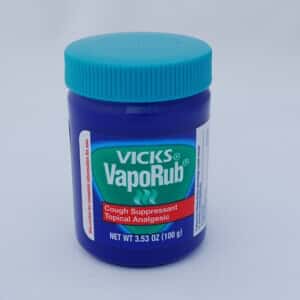
Vicks VapoRub is a venerable brand. It was developed by pharmacist Lunsford Richardson in Greensboro, North Carolina, not long before the turn of the 20th century. Richardson had a long last name and a little blue bottle for his salve, so he used his brother-in-law’s name on the label. Not only did it fit; Dr. Joshua Vick was a physician with an excellent reputation in the city. Vicks VapoRub got a huge boost in brand recognition during the Spanish flu epidemic of 1918. Americans have been using it for colds and coughs ever since then. But once in a while, someone runs into trouble with Vicks VapoRub.
Trouble with Vicks VapoRub:
Q. I had a bad cold with a cough recently and rubbed Vicks on my chest and in my nose. I got a burn on my chest similar to a bad sunburn, with little bumps.
I read the Vicks label and it cautions against putting Vicks in the nostrils. But that’s how most of my friends and relatives usually use it.
Two questions: Should I put Vicks in my nose and, second, if it burns my chest, could it burn my feet so I couldn’t even walk?
Staying Out of Trouble with Vicks VapoRub:
A. Do NOT put Vicks VapoRub in your nostrils. The petroleum jelly base, if inhaled, could irritate the lungs and cause pneumonitis. Here is another reader’s experience with lipoid pneumonia due to putting Vicks in the nose. This form of pneumonia is not caused by pathogens but by the tissues’ reaction to the petrolatum. It is very hard to treat (Hadda and Khilnani, Expert Review of Respiratory Medicine, Dec. 2010).
That is one reason we have recommended putting Vicks on the soles of the feet. The feet are far enough away from the nose that pneumonitis is not a concern.
Your skin reaction is of concern, however. You might be sensitive to one of the ingredients in Vicks, possibly camphor, eucalyptol or menthol. You would do well to avoid it completely.
There is more information about Vicks VapoRub in our Guide to Unique Uses for Vicks.

